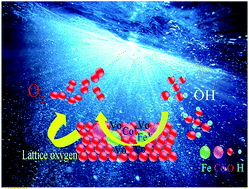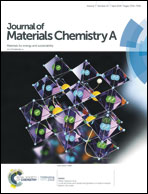Prussian blue analog-derived 2D ultrathin CoFe2O4 nanosheets as high-activity electrocatalysts for the oxygen evolution reaction in alkaline and neutral media†
Abstract
Developing highly efficient and stable oxygen evolution reaction (OER) catalysts is of vital importance for large-scale energy storage and conversion technologies. Herein, we report a simple and facile strategy to synthesize 2D ultrathin CoFe2O4 nanosheets (NSs) with abundant oxygen vacancies by the reduction of Prussian blue analogs (PBAs) at room temperature using NaBH4. With large surface area, high density of surface-active sites, high electron transfer capability and durability, CoFe2O4 NSs show a low overpotential of 275 mV at 10 mA cm−2 with a Tafel slope of 42.1 mV dec−1 for the OER in alkaline medium, which is superior to that of the benchmark RuO2. What's more, CoFe2O4 NSs also exhibit a high catalytic activity for the OER with a low onset potential of 1.505 V and a high current density of 4.8 mA cm−2 at 1.8 V in neutral medium. Both the oxygen vacancies and the synergistic effect between oxygen vacancies and Co3+ contribute to the excellent OER activity of CoFe2O4 NSs. Our finding opens up a new general route for developing highly efficient electrocatalysts for the OER.



 Please wait while we load your content...
Please wait while we load your content...